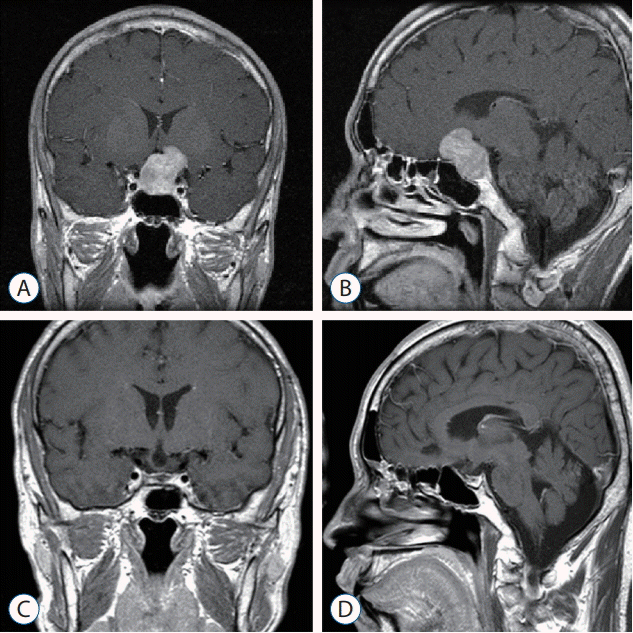INTRODUCTION
MATERIALs AND METHODS
Patients
Preoperative and postoperative laboratory tests
Surgery and follow-up
RESULTS
 | Fig. 1.Various radiological findings of TSH-secreting pituitary adenomas. A–F : Various shapes and sizes of TSH-PA tumors. All of these patients underwent transnasal transsphenoidal surgery and experienced endocrinological remission. TSH : thyroid-stimulating hormone, PA : pituitary adenoma. |
 | Fig. 2.Representative case of TSH-secreting pituitary adenomas. In a 33-year-old male patient, the tumor grew in the suprasellar area and extended to the anterior cranial fossa. The patient underwent combined transnasal transsphenoidal surgery followed by transcranial surgery via left pterional craniotomy. Postoperative endocrinological remission was achieved (A and B : preoperative sagittal and coronal T1-weighted enhanced MRI image, C and D : postoperative coronal and sagittal T1-weighted enhanced MRI image). TSH : thyroid-stimulating hormone, MRI : magnetic resonance imaging. |
 | Fig. 3.A : Monomorphic cell with granular cytoplasm, round nuclei, and dispersed chromatin are present in the adenoma (Hematoxylin-Eosin staining, ×100). B-D : Immunostaining for TSH, ACTH, GH, and tumor showed positivity for TSH (B : TSH immuostaining, ×4; C : ACTH immunostaining, ×40; D : GH immunostaining, ×40). TSH : thyroid-stimulating hormone, ACTH : adrenocorticotropic hormone, GH : growth hormone. |
Table 1.
 | Fig. 4.A case of recurrent TSH-secreting pituitary adenoma. A : A 46-yearold female patient with a tumor located on left side of the sella and deviated pituitary stalk on brain MRI. The patient underwent transnasal transsphenoidal surgery and experienced hormonal remission after surgery. B : Follow-up MRI performed at postoperative 3 months showed no evidence of residual tumor. C and D : Gamma knife radiosurgery planning image; irradiation field included sella and left cavernous sinus. TSH : thyroid-stimulating hormone, MRI : magnetic resonance imaging. |
 | Fig. 5.Kaplan-Meier analysis of recurrence-free survival. Recurrence-free survival of enrolled patients. The 5-year and 20-year recurrence-free survival rates were 88.9% and 76.2%, respectively. TSH : thyroid-stimulating hormone. |
Table 2.
Preop : preoperative, Postop : postoperative, TSH : thyroid-stimulating hormone, fT4 : free T4, POD : postoperative day, NA : not applicable, TRH : thyrotropin-releasing hormone, TSA : transsphenoidal approach, TCA : transcranial approach, PTU : propylthiouracil, SHBG : sex hormone-binding globulin, MTZ : methimazole




 PDF
PDF Citation
Citation Print
Print



 XML Download
XML Download